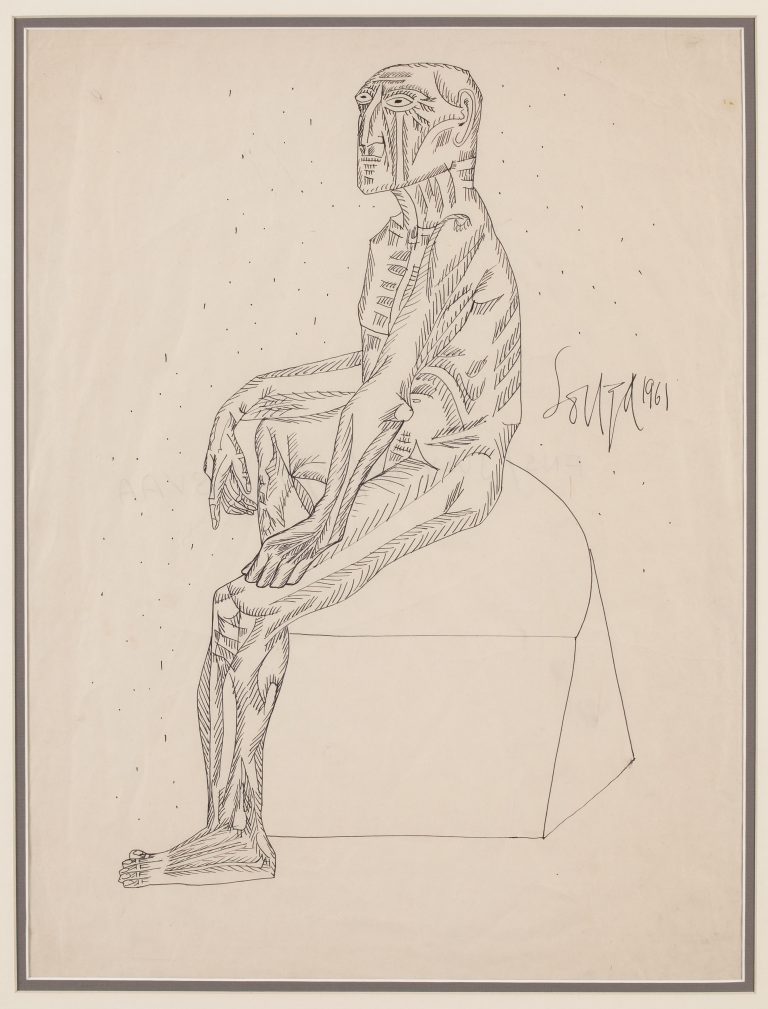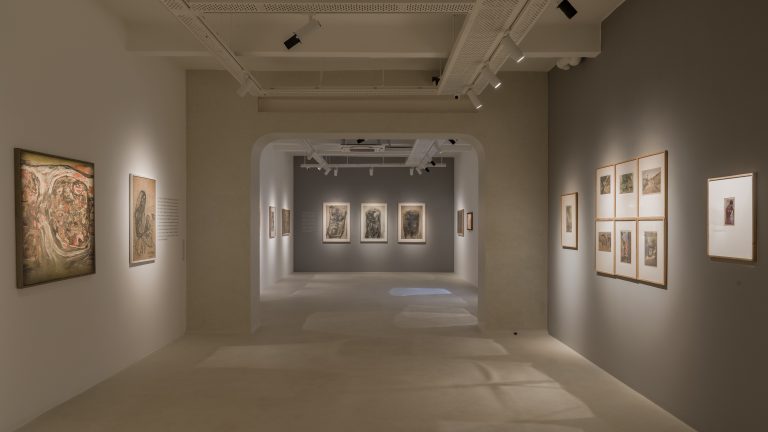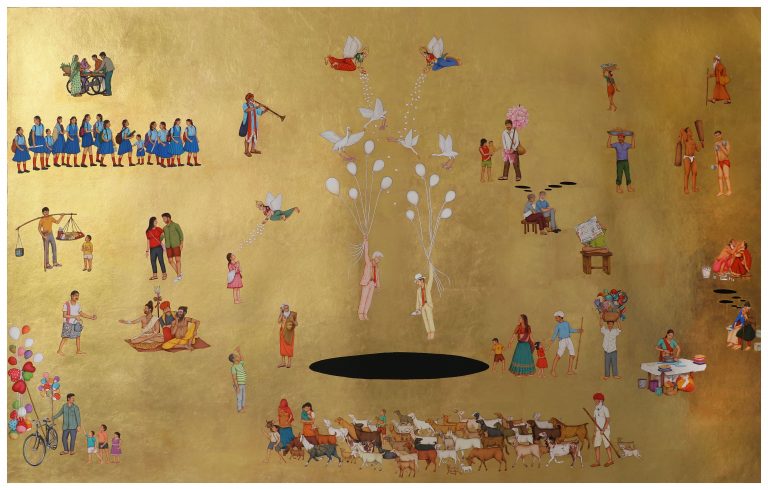Black is part of the renaissance of aesthetics as well as a thorn in the side of the western canon. It is a social space and a civil rights movement, a fashion statement and a designers dream. It is both fear and beauty rolled into one and it can be an attitude and a tradition.
![]()
Every decade brings with it its own crop of slogans and catchphrases originating in popular culture, and propagated by mass media and the sum of which then go on to define the complex pattern or structure of the reality experience. At the turn of the century during the early 2000s we had ‘globalisation’, ‘instant messaging’, ‘internet dating’ and the likes along with ‘corporatisation of the art scene’, to give an intimation of what the decade was going to shape into. And when corporatisation of the art scene turned around and resolved into hard edged reality, it settled across the art scene both disorienting and reorienting the whole picture, calling for drastic manoeuvring depending on where you stood in relation to the overall scene.
![]()
On the positive side, the much hyped corporatisation bumped up art prices and thrust Indian contemporary art into the spotlight on the global arena. The most obvious and fortuitous fallout was artists for a change could afford essentials such as spacious well lit studios, better living conditions, and garner resources which in turn translated into self-assurance and the elbow room to produce experimental work. The resulting media blitz also brought in a higher degree of social acceptance to the profession which earlier had a rather ambiguous social status. On the negative side art aficionados and collectors got served art that was traded at ever increasing prices between and among a closed circle investors creating the illusion of price point appreciation, and the speculation-driven buying-spree. The demand spiral also transformed a few artist’s studios into minor sweatshops to accommodate the pull of the market. But the most disconcerting outcome was that the academic mainstream relinquished its overarching hegemony and became a sleeping partner in the joint enterprise of the market.
![]()
The power shift that occurred during this passing of the baton from the academic mainstream to the market defined art scene did open up the Indian art scene significantly, providing visibility to a fairly large number of talented artists who otherwise would have remained unknown. A fact that reiterates the obvious, which is the academic mainstream being the establishment that controls and regulates the art scene is not an inclusive space vis-a-vis the market driven corporatised art scene.
The truth is one acknowledges the necessary requirement of a criteria translated into a code of conduct and the mechanism to implement that code through a chain of hierarchies operating as filters that segregate and weed out all that is ‘undesirable’ and detrimental to the coherence of the established consensus. Unfortunately one also keeps observing repeatedly how inevitable moral entropy settles in and undermines genuine and honest intentions, so that we end up in a situation where lofty ideals and intentions are distorted and consensus become a tormentor and an obstacle in its determination to perpetuate a vacuous status quo. Linguist and literary critic Roger Fowler presents status quo as being the common sense ideas of a period of time. But when such status quo are habitualised, it leads to a collective thinking that increasingly becomes uncritical. Without being overtly cynical, one can conclude that the hierarchical setup that provides the necessary strength to the framework would invariably contain hidden weak links that through self-interest eventually sabotage the setup. Fowler goes on to state that it is the function of art to investigate such status quo and to force society to look critically at the established ideas that are blindly accepted as fact. Without being overtly cynical one can conclude that the hierarchical setup that provides the necessary strength to the framework would invariably contain hidden weak links that, driven by self-interest, would eventually sabotage the setup.
![]()
Given that kind of double bind it is not surprising that auction price indices were co-opted as the guideline for quality, though one still marvels at the relative ease with which it was accomplished. The most obvious reason for this condition could be that the Indian art scene is not stabilised by key art historical texts and narratives unlike its counter parts elsewhere such as the American or British art scene. Instead it relies entirely on opinions and guesswork or the stamp of approval by a western collector or curator to arbitrarily position an artist and his/her works without caring about track record and actual contributions within the growing pantheon of Indian artists and their multifarious practices. The end result is that no one has the definitive snapshot of the Indian art scene, or one could say that there are one too many snapshots floating around conveniently representing differing vested interests.
![]()
There could be any number of reasons for this appalling lacuna. One could probably site as the main reason the deep rooted and culturally ingrained reluctance to objectify history, and therefore the non-existence of a so called museum culture, and consequently inadequate state funding to document the generation and propagation of visual culture. Yet another important factor which is at the root of this condition, one that is ignored or never taken into account is the total absence of an underground art scene, the non-existence of a vibrant ‘unofficial’ art stream as a counter point to the mainstream within the Indian art scene. A space where artists can test home grown ideas, push existing envelopes, and make syntactical and formal discoveries without being self-conscious of the critical gaze and avoid falling into the trap of shaping one’s work to lure curatorial gaze and to match gallery profiles.
![]()
The actual origins of the terminology ‘unofficial art’ lie in the erstwhile Soviet Union before it splintered into separate autonomous regions and countries. Originally it was a term that was used to define art produced in the Soviet Union that did not conform to the ideals of Socialist Realism, which was the officially sanctioned style of the state in 1932 as any form of artistic independence was virtually impossible at that time. Later the scene changed under Stalin’s successor Nikita Khrushchev, and unofficial art began to appear in public in around 1960. The Soviet unofficial art was stylistically varied and individualistic, and around 1970 a distinctive strand emerged known as ‘Sots Art’, which mocked the conventions of Socialist Realism which was the official and approved art. Vitaly Komar and Alexander Melamid, inventors of Sots Art, used the methodology of tweaking well-known Soviet symbols and icons, often replacing Lenin and Stalin’s portraits with their own, and autographing famous Soviet slogans and catch-phrases with their artistic signatures. The current contemporary Chinese art and the emerging stream of cynical realism that is gaining popularity has its roots in the unofficial Sots Art of the 1970s.
Underground art movements would offer a more egalitarian and creatively open environment as they strive to exist away from the impulses and motivations that drive the mainstream art market ecology. It would be a place or space where art historians can track the growth of streams of inclinations that are indigenous and which would evolve and get absorbed into the visual culture of the time enriching and expanding it. But it would operate as a place devoid of hierarchies and which is insulated from the direct purview of the establishment. Cultish appraisals and groupie writing would naturally emerge from within this space first, and then the wider circle of critics from the mainstream could draw upon this writing to inform their own judgment and coupled with such informed observation generate bona fide critical writing. This tiered transfer of information and the resulting analysis at the point of origin is an essential foundation for a localized art historical narrative to come into being.
![]()
Currently within the global arena a genuine contender for the position of alternative art, qualified by its total lack of compulsion to justify its existence by invoking art historic canons is the ‘lowbrow art movement’. ‘Lowbrow’ art is a rather undefined and open ended stream of art that is gradually gaining currency across the globe. While art that populates the academic mainstream draws its guidelines and material from art history and especially the western canon to justify and evaluate itself, the lowbrow stream by contrast draws its sustenance from popular culture and all those expressions ranging from calendar art and tattoo art and even pornography. In short all that is excluded and dismissed by the academic mainstream as retrograde, kitschy, and populist is the source material for lowbrow.
Lowbrow actually had its origins as an underground visual art movement in Los Angeles, California, in the late 1970s. The credit for originating the term ‘lowbrow art’ belongs to Robert Williams, a Los Angeles artist and underground cartoonist. In 1979 while producing a book featuring his paintings, Williams decided to give the book the self-deprecating title, ‘The Lowbrow Art of Robert Williams’, since it was obvious that no art institution would recognise what he was doing as art. He used the term ‘lowbrow’ as a qualifier in opposition to ‘highbrow art’. And the name stuck, becoming an umbrella term to include all kinds of art that is off beat and contrary to the mainstream. Eventually it became a widespread populist art movement fed by the underground comics, punk music, hot-rod street culture, and various other subcultures that exist tangentially to the dominant ethos.
Lowbrow’s core dynamics do resemble art movements of the early 20th century, especially the Dadaists and artists such as Marcel Duchamp and in the manner they questioned the distinctions between high and low art, popular culture and high art culture. The partnership between information revolution and the internet has helped spreading lowbrow from its point of origin to the outside world and as of today alternative spaces that are dedicated to showcasing lowbrow art has sprung up such as the Billy Shire gallery, Zero One gallery, and others in mainland USA as well as 12 Midnite gallery in Canada, UFO gallery in Hong Kong, and a sprinkling of sites across Europe and UK. As for publications that chronicle the art produced as well as carry literature on artists there are a number of publications with Juxtapoz Magazine being the definitive mouthpiece of lowbrow, Dangerous Ink from UK is yet another publication that exclusively features lowbrow art, likewise Stirato is published from Italy, and Tokion is another lowbrow magazine published both in English and Japanese. As lowbrow gains popularity and is becoming a true global phenomenon, there has been attempts to classify or categorise it as ‘Pop Surrealism’ by mainstream critics and historians, but in actuality the very fact that it represents a sensibility that tries to circumvent the established art canons and the fact that lowbrow art is about exploring and critiquing those distinctions makes it leap over such narrow definitions.
Given the fact that the rhythmic thump of the auctioneer’s mallet has now almost faded into the background noise, the time seem to be ripe for some kind of unofficial art scene to bloom into existence in India. As the lowbrow art movement has spread around the world, it has intermingled with the tendencies in the visual culture from those locations where it gets adopted which of course is a mark of its fluid, de-centralised non-hierarchical makeup. And that makes it an ideal open ended platform for unofficial art to flourish irrespective of locations embracing cultural idiosyncrasies without self-consciousness. One hopes that in the coming days lowbrow could very well take roots within the Indian art scene as well, with dedicated exhibition spaces and publications filling in the void which exists due to the absence of an unofficial art scene, thus bringing in a much more open and less self-conscious environment to evolve and track nascent and experimental and unconventional art, eventually linking across geographical boundaries with the help of the information network to be part of a pan global underground.
Image Courtesy:
Jon Beinart – www.beinart.org
Leslie Ditto – www. leslieditto.com
Ron English and Van Arno – www.hour.ca
Yoko D’ Holbachie – www.dholbachie.com
Ideekay art – www.flickr.com/photos/ideekay
Udith Supine – www.arrestedmotion.com
Ray Caesar – www.raycaesar.com
Robert Williams – www.robtwilliamsstudio.com
All images provided by Baiju Parthan, Copyrights with respective artists.














